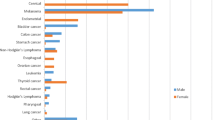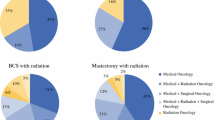Abstract
Purpose
The study purpose is to describe who breast cancer survivors see for their care by years since diagnosis and determine the association between time since diagnosis and the type of clinician providing the majority of care, taking into account receipt of follow-up care instructions.
Methods
The 2010 Behavioral Risk Factor Surveillance System was used to identify a sample (N = 1024) of women with a self-reported history of breast cancer. Descriptive characteristics were calculated and stratified by years since diagnosis. Multivariate logistic regression adjusting for age, income, and receiving follow-up care instructions was performed to evaluate the association between years since diagnosis and clinician providing the majority of care.
Results
The type of clinician reported most frequently was a primary care provider. Women 0–1 year since diagnosis had the highest proportion reporting a cancer-related clinician for their care. After adjustment, women 0–1, 2–3, and 4–5 years since diagnosis were respectively 2.1, 2.6, and 1.7 times more likely to have a cancer-related clinician providing the majority of care compared to women 6+ years since diagnosis (respective 95 % confidence intervals (CIs) 1.0–4.3; 1.4–4.6; 0.9–3.1).
Conclusions
Breast cancer survivors receive the majority of their care from primary care providers, and years since diagnosis has a significant impact on who survivors see for their care. Breast cancer survivors have nationally recommended follow-up guidelines; however, the type of clinician that should provide care is not specified. Information regarding who provides the majority of care can be used for future planning and policy development.
Similar content being viewed by others
References
American Cancer Society (2014) Cancer facts & figures 2014. American Cancer Society, Atlanta, GA
Hewitt M, Greenfield S, Stovall E (eds) (2005) From cancer patient to cancer survivor: lost in transition. The National Academies Press, Washington, DC
American Cancer Society (2013) Breast cancer facts & figures 2013-2014. American Cancer Society, Atlanta, GA
Centers for Disease Control and Prevention (CDC) (2011) Cancer survivors—United States, 2007. MMWR Morb Mortal Wkly Rep 60:269–272
National Comprehensive Care Network (2012) NCCN clinical practice guidelines in oncology (NCCN guidelines)® breast cancer. Version 1.2012
Khatcheressian JL, Wolff AC, Smith TJ et al (2006) American Society of Clinical Oncology 2006 update of the breast cancer follow-up and management guidelines in the adjuvant setting. J Clin Oncol 24:5091–5097
Friese CR, Martinez KA, Abrahamse P et al (2014) Providers of follow-up care in a population-based sample of breast cancer survivors. Breast Cancer Res Treat 144:179–184
Grunfeld E, Levine MN, Julian JA et al (2006) Randomized trial of long-term follow-up for early-stage breast cancer: a comparison of family physician versus specialist care. J Clin Oncol 24:848–855
Grunfeld E, Earle CC (2010) The interface between primary and oncology specialty care: treatment through survivorship. J Natl Cancer Inst Monogr 2010:25–30
Lewis RA, Neal RD, Williams NH et al (2009) Follow-up of cancer in primary care versus secondary care: systematic review. Br J Gen Pract 59:e234–e247
Friedberg MW, Hussey PS, Schneider EC (2010) Primary care: a critical review of the evidence on quality and costs of health care. Health Aff (Millwood) 29:766–772
Grunfeld E, Mant D, Yudkin P et al (1996) Routine follow up of breast cancer in primary care: randomised trial. BMJ 313:665–669
Grunfeld E, Hodgson DC, Del Giudice ME, Moineddin R (2010) Population-based longitudinal study of follow-up care for breast cancer survivors. J Oncol Pract 6:174–181
Keating NL, Landrum MB, Guadagnoli E, Winer EP, Ayanian JZ (2007) Surveillance testing among survivors of early-stage breast cancer. J Clin Oncol 25:1074–1081
Worster A, Wood ML, McWhinney IR, Bass MJ (1995) Who provides follow-up care for patients with early breast cancer? Can Fam Physician 41:1314–1320
Mandelblatt JS, Lawrence WF, Cullen J et al (2006) Patterns of care in early-stage breast cancer survivors in the first year after cessation of active treatment. J Clin Oncol 24:77–84
Pollack LA, Adamache W, Ryerson AB, Eheman CR, Richardson LC (2009) Care of long-term cancer survivors: physicians seen by Medicare enrollees surviving longer than 5 years. Cancer 115:5284–5295
Chubak J, Aiello Bowles EJ, Tuzzio L et al (2014) Perspectives of cancer survivors on the role of different healthcare providers in an integrated delivery system. J Cancer Surviv 8:229–238
Jabson JM, Bowen DJ (2013) Cancer treatment summaries and follow-up care instructions: which cancer survivors receive them? Cancer Causes Control 24:861–871
Center for Disease Control and Prevention. Overview: BRFSS 2010. http://www.cdc.gov/brfss/annual_data/2010/overview_10.pdf. Accessed 01 May 2014
Center for Disease Control and Prevention. Behavioral risk factor surveillance system 2010 summary data quality report (version #1 - revised: 05/02/2011). ftp://ftp.cdc.gov/pub/data/brfss/2010_summary_data_quality_report.pdf. Accessed 01 May 2014
Center for Disease Control and Prevention. Questionnaires: modules by category (2010). http://apps.nccd.cdc.gov/BRFSSModules/ModByCat.asp?Yr=2010. Accessed 01 May 2014
Azrad M, Demark-Wahnefried W (2014) The association between adiposity and breast cancer recurrence and survival: a review of the recent literature. Curr Nutr Rep 3:9–15
American Cancer Society (2012) Breast cancer facts & figures 2011–2012. American Cancer Society, Atlanta, GA
Roorda C, de Bock GH, Scholing C, van der Meer K et al (2014) Patients’ preferences for post-treatment breast cancer follow-up in primary care vs. secondary care: a qualitative study. Health Expect. doi:10.1111/hex.12189
Saphner T, Tormey DC, Gray R (1996) Annual hazard rates of recurrence for breast cancer after primary therapy. J Clin Oncol 14:2738–2746
Potosky AL, Han PK, Rowland J et al (2011) Differences between primary care physicians’ and oncologists’ knowledge, attitudes and practices regarding the care of cancer survivors. J Gen Intern Med 26:1403–1410
Sabatino SA, Thompson TD, Smith JL et al (2013) Receipt of cancer treatment summaries and follow-up instructions among adult cancer survivors: results from a national survey. J Cancer Surviv 7:32–43
Oeffinger KC, McCabe MS (2006) Models for delivering survivorship care. J Clin Oncol 24:5117–5124
Oeffinger KC, Argenbright KE, Levitt GA et al (2014) Models of cancer survivorship health care: moving forward. Am Soc Clin Oncol Educ Book: 205–213
Conflict of interest
The authors declare that they have no conflicts of interest. The authors had access to all data, performed all analyses for this study, and agree to allow the journal to review their data if requested.
Author information
Authors and Affiliations
Corresponding author
Rights and permissions
About this article
Cite this article
Wiseman, K.P., Bishop, D.L., Shen, Q. et al. Survivorship care plans and time since diagnosis: factors that contribute to who breast cancer survivors see for the majority of their care. Support Care Cancer 23, 2669–2676 (2015). https://doi.org/10.1007/s00520-015-2629-5
Received:
Accepted:
Published:
Issue Date:
DOI: https://doi.org/10.1007/s00520-015-2629-5




